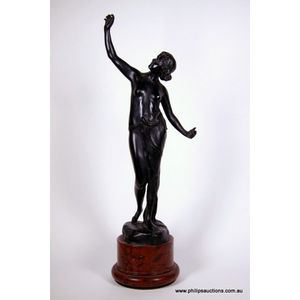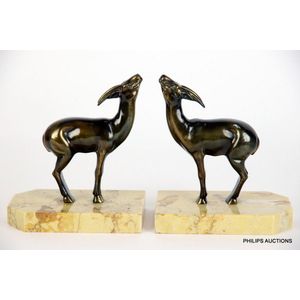Spelter Gazelle Bookends, 1930
You must be a subscriber, and be logged in to view price and dealer details.
Subscribe Now to view actual auction price for this item
When you subscribe, you have the option of setting the currency in which to display prices to $Au, $US, $NZ or Stg.
- Circa - A Latin term meaning 'about', often used in the antique trade to give an approximate date for the piece, usually considered to be five years on either side of the circa year. Thus, circa 1900 means the piece was made about 1900, probably between 1895 and 1905. The expression is sometimes abbreviated to c.1900.
- Bronze - An alloy of copper and tin, traditionally in the proportions of about 9 parts of copper to 1 part of tin.
The discovery of bronze in Western Asia in the 4th century enabled people to create metal objects which were superior to those previoulsy possible because of its strength and hardness, and it has been used throughout the world for weapons, coins, tools, statuary and other decorative items.
It is very fluid in a molten state, and its hardness, strength when set, and non-corrosive properties makes it most suitable for casting sculpture. - Terracotta - Terracotta is lightly fired earthenware, red or reddish-brown in colour, used in ancient times. Fired at higher temperatures terracotta was used in the nineteenth century for decorative vases and similar objects, but rarely for utilitarian goods. Other uses for terracotta include roofing tiles, garden pots and ornaments. Glazed terracotta is known as faience.
- Spelter - Spelter was the name given to an alloy of zinc and brass or copper used in the 19th century for statuary and lighting. It is a brittle bluish-white metal. It was used as a cheap replacement for bronze, but being brittle easily breaks and can't be repaired. When finished it can often be mistaken for bronze, but if discreet a scratch on the base displays shows a greyish colour, the metal is spelter, if a golden colour the metal is most likely bronze.
This item has been included into following indexes:
Visually similar items

Bronze figure of young boy, c. 1930, with arms outstretched, signed to base 'Rohn'. Height 28 cm

An Austrian bronze figure by Franz Pelecshka, early 20th century, the Art Nouveau figure of a serene semi-clad female figure in draping robes in a serpentine pose, one arm elegantly raised, in near black bronze and supported on a flecked red marble base; s

Early 19th century English gilt bronze candlestick, the stem cast of a stork on a flared gilt base. Circa 1830. 40 cm high.

Armand Sinko: Art Deco bronze statue of birds, signed on black slate base. Height 33.5 cm, width 47 cm, depth 15 cm
